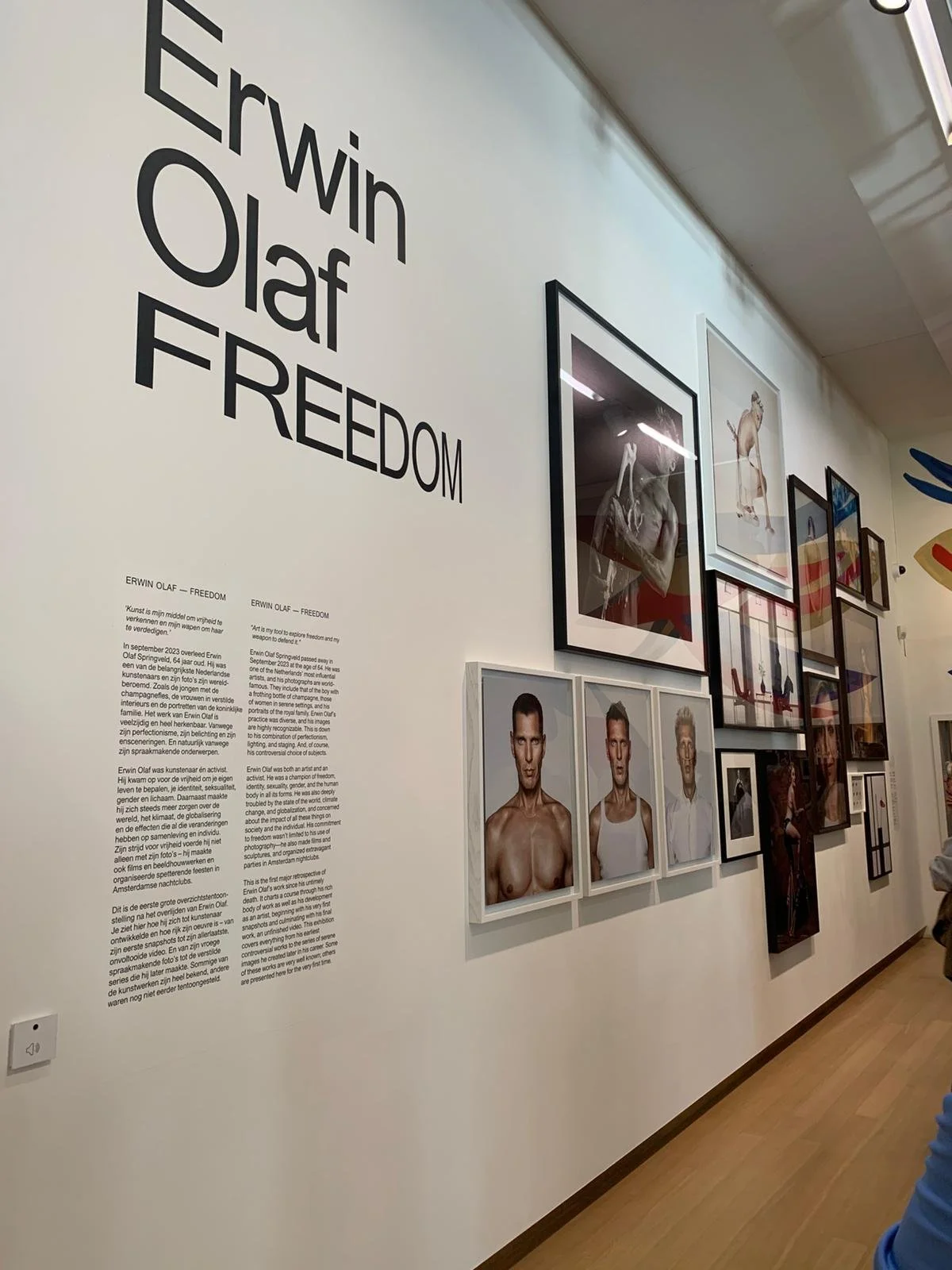A Gallery of Carefully Broken Rules - Erwin Olaf - Learning the Shape of Freedom
The first thing I notice is how ordered everything is.
On the long white wall, the word FREEDOM is printed in large, clean letters next to Erwin Olaf’s name. Below, the photographs are hung in a tight grid: bodies, faces, interiors, gestures. Nothing is crooked. Nothing is casual. It’s a display of control.
It’s an almost ironic way to enter an exhibition about freedom.
Erwin Olaf (1959–2023) was one of the Netherlands’ most influential photographers, known for his meticulously staged images that blend fashion gloss with social tension. His work has long circled around themes of emancipation, sexuality and the right to exist in your own body and identity, even when the world would rather look away.
Here, in the Stedelijk Museum in Amsterdam, that long trajectory of work is compressed into a single wall. It feels like walking into a compact biography written in skin, fabric and light.
Sculpted bodies, fragile faces
At a distance, the large portraits look almost classical. Bare torsos, strong shoulders, chiseled jawlines: men posed like contemporary sculptures. Step closer and the illusion starts to flicker. Their expressions are slightly too stiff, the skin slightly too smooth, the eyes holding something between challenge and unease.
In one photograph, a man’s body is caught mid-movement, liquid splashing across his chest like a frozen explosion. In another, a figure crouches in a pale, almost clinical space, his back turned, his body both elegant and strangely vulnerable. Elsewhere, a row of faces appears: the same man repeated in different outfits, from tank top to white shirt to stylised, almost androgynous presentation, as if we are seeing him trying on identities like costumes.
Olaf’s work often looks polished to the point of perfection - every light, every shadow, every wrinkle in fabric under strict control. But that polish isn’t there to reassure us. It’s there to make the crack more visible. Behind each glamorous surface there is discomfort, shame, desire, or loneliness, waiting like a second exposure underneath the first.
Freedom, in these images, is not a given. It’s a negotiation.
The staged room as a pressure cooker
Many of Olaf’s series have the feeling of miniature theatre stages: carefully designed interiors where characters act out private stories under a bright, unforgiving spotlight. From his earlier black-and-white work confronting queer identity and homophobia, to later series such as Rain, Grief, April Fool or Palm Springs, he uses rooms like pressure cookers - places, where social roles, expectations and inner conflicts are turned up to a visible boil.
On this wall, that theatrical feeling is still present, even when we only see fragments. A woman perched on an exercise bike, dressed and lit as if she is both pin-up and prisoner. An elegant figure sitting alone at a long table in a cold, corporate interior. A body underwater, or a back turned firmly away from us.
Every photograph seems to be asking the same question in a different costume:
How much of myself can I show without losing safety?
How much freedom can I claim before I am punished for it?
The answer is never simple. Olaf doesn’t offer heroic liberation scenes or easy empowerment. Instead, he shows us the in-between state: the moment where someone holds a pose that isn’t quite comfortable, but refuses to drop it. That stubbornness - the decision to remain visible even when it hurts - is one of the most moving forms of freedom in his work.
Freedom as performance
Walking along the wall, I became very aware of my own body in the space. The polished wooden floor, the white walls, the quiet hum of people reading the text panel - it all feels like part of the staging. We viewers are just as choreographed as the subjects in the photographs. We stop, lean in, step back, fold our arms, tilt our heads. Without noticing, we are performing “museum visitor”.
Olaf understood performance intimately. As a gay man, who came of age in a time of fierce battles over visibility and equal rights, he knew that the body could be both a site of pleasure and a political statement. Many of his portraits embrace camp, glamour and exaggeration as tools of resistance: if society has already decided to stare at you, you might as well take control of how you are seen.
In this sense, the title Freedom is not about a relaxed, natural state. It is about the right to craft your own appearance, to decide your own script - even if that script includes discomfort, contradiction, and masks.
Freedom here is not the absence of a frame. It is the ability to use the frame for your own story.
After the wall
When I finally turned away from Olaf’s portraits, the rest of the museum looks slightly different. The white corridors, the neat lines, the polite silence - all of it feels less neutral. I started to think about, how many rules of behaviour, gender, beauty and success are silently attached to these kinds of spaces.
Olaf’s work doesn’t tear those rules down. Instead, it exaggerates them until they become visible, even ridiculous. He shows us bodies that are too posed, too perfect, too polished and in that excess we start to see the cage that “normality” builds around us.
Maybe that is the quiet power of this exhibition. It does not shout slogans about freedom. It asks us to notice where we are still holding our breath, still tightening our shoulders, still editing ourselves before the world can do it for us.
Standing in front of that wall one last time, I realized that freedom, in Olaf’s universe, is not a wide open field. It is a small room, where someone decides, against all pressure, to keep looking straight into the camera.

